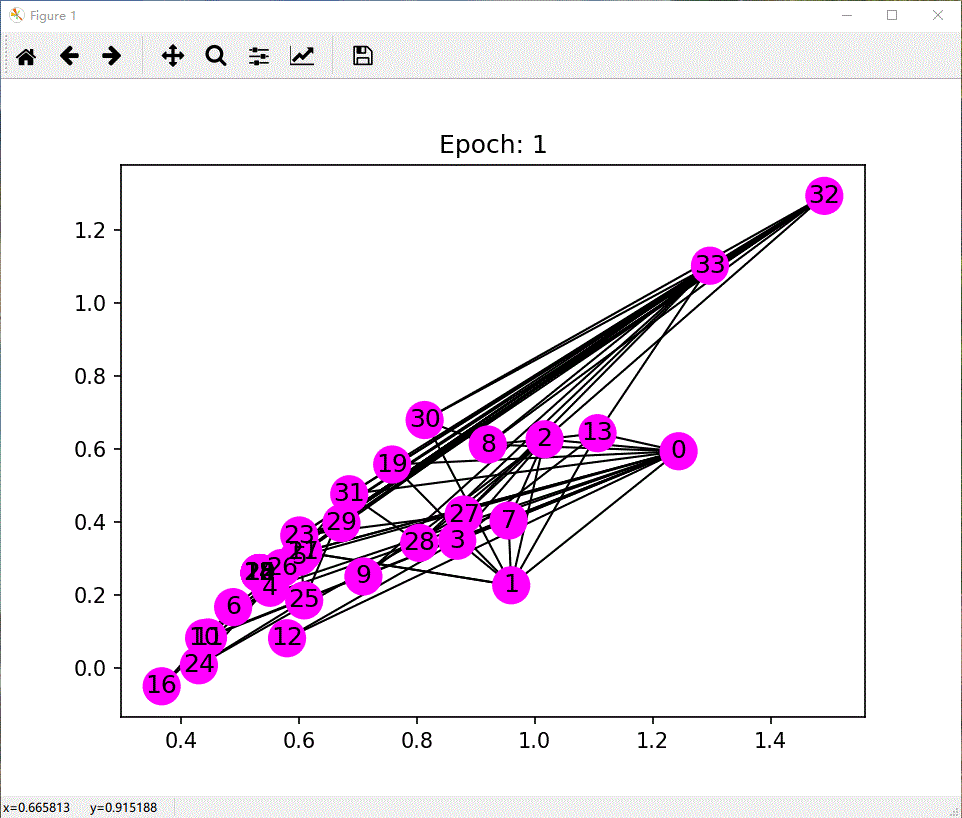原文首发于个人站点 基于PyTorch-DGL 实现图卷积网络 | 梦家
更新:
在此附上图卷积网络GCN理论篇:
- 图卷积网络GCN(Graph Convolution Network)(一)研究背景和空域图卷积
- 图卷积网络GCN(Graph Convolution Network)(二)图上的傅里叶变换和逆变换
- 图卷积网络GCN(Graph Convolution Network)(三)详解三代图卷积网络理论
基于PyTorch框架实现图卷积神经网络
项目源代码参考本人Github.
依赖库
- DGL 0.1.3
- PyTorch 0.4.1
- networkX 2.2
利用DGL构建图
# -*- coding: utf-8 -*-
"""
@Date: 2019/1/11
@Author: dreamhome
@Summary: DGL graph.
"""
import dgl
import torch
import networkx as nx
import matplotlib.pyplot as plt
def build_karate_club_graph():
g = dgl.DGLGraph()
# add 34 nodes into the graph; nodes are labeled from 0~33
g.add_nodes(34)
# all 78 edges as a list of tuples
edge_list = [(1, 0), (2, 0), (2, 1), (3, 0), (3, 1), (3, 2),
(4, 0), (5, 0), (6, 0), (6, 4), (6, 5), (7, 0), (7, 1),
(7, 2), (7, 3), (8, 0), (8, 2), (9, 2), (10, 0), (10, 4),
(10, 5), (11, 0), (12, 0), (12, 3), (13, 0), (13, 1), (13, 2),
(13, 3), (16, 5), (16, 6), (17, 0), (17, 1), (19, 0), (19, 1),
(21, 0), (21, 1), (25, 23), (25, 24), (27, 2), (27, 23),
(27, 24), (28, 2), (29, 23), (29, 26), (30, 1), (30, 8),
(31, 0), (31, 24), (31, 25), (31, 28), (32, 2), (32, 8),
(32, 14), (32, 15), (32, 18), (32, 20), (32, 22), (32, 23),
(32, 29), (32, 30), (32, 31), (33, 8), (33, 9), (33, 13),
(33, 14), (33, 15), (33, 18), (33, 19), (33, 20), (33, 22),
(33, 23), (33, 26), (33, 27), (33, 28), (33, 29), (33, 30),
(33, 31), (33, 32)]
# add edges two lists of nodes: src and dst
src, dst = tuple(zip(*edge_list))
g.add_edges(src, dst)
# edges are directional in DGL; make them bi-directional
g.add_edges(dst, src)
return g
if __name__ == '__main__':
G = build_karate_club_graph()
print('%d nodes.' % G.number_of_nodes())
print('%d edges.' % G.number_of_edges())
fig, ax = plt.subplots()
fig.set_tight_layout(False)
nx_G = G.to_networkx().to_undirected()
pos = nx.kamada_kawai_layout(nx_G)
nx.draw(nx_G, pos, with_labels=True, node_color=[[0.5, 0.5, 0.5]])
plt.show()
# assign features to nodes or edges
G.ndata['feat'] = torch.eye(34)
print(G.nodes[2].data['feat'])
print(G.nodes[1, 2].data['feat'])
构建图卷积神经网络
# -*- coding: utf-8 -*-
"""
@Date: 2019/1/14
@Author: dreamhome
@Summary: define a Graph Convolutional Network (GCN)
"""
import torch
import torch.nn as nn
def gcn_message(edges):
"""
compute a batch of message called 'msg' using the source nodes' feature 'h'
:param edges:
:return:
"""
return {'msg': edges.src['h']}
def gcn_reduce(nodes):
"""
compute the new 'h' features by summing received 'msg' in each node's mailbox.
:param nodes:
:return:
"""
return {'h': torch.sum(nodes.mailbox['msg'], dim=1)}
class GCNLayer(nn.Module):
"""
Define the GCNLayer module.
"""
def __init__(self, in_feats, out_feats):
super(GCNLayer, self).__init__()
self.linear = nn.Linear(in_feats, out_feats)
def forward(self, g, inputs):
# g is the graph and the inputs is the input node features
# first set the node features
g.ndata['h'] = inputs
# trigger message passing on all edges
g.send(g.edges(), gcn_message)
# trigger aggregation at all nodes
g.recv(g.nodes(), gcn_reduce)
# get the result node features
h = g.ndata.pop('h')
# perform linear transformation
return self.linear(h)
class GCN(nn.Module):
"""
Define a 2-layer GCN model.
"""
def __init__(self, in_feats, hidden_size, num_classes):
super(GCN, self).__init__()
self.gcn1 = GCNLayer(in_feats, hidden_size)
self.gcn2 = GCNLayer(hidden_size, num_classes)
def forward(self, g, inputs):
h = self.gcn1(g, inputs)
h = torch.relu(h)
h = self.gcn2(g, h)
return h
if __name__ == '__main__':
net = GCN(34, 5, 2)
训练过程
# -*- coding: utf-8 -*-
"""
@Date: 2019/1/14
@Author: dreamhome
@Summary: train semi-supervised setting
"""
import torch
import torch.nn.functional as F
import networkx as nx
import matplotlib.animation as animation
import matplotlib.pyplot as plt
from model import GCN
from build_graph import build_karate_club_graph
import warnings
warnings.filterwarnings('ignore')
net = GCN(34, 5, 2)
print(net)
G = build_karate_club_graph()
inputs = torch.eye(34)
labeled_nodes = torch.tensor([0, 33]) # only the instructor and the president nodes are labeled
labels = torch.tensor([0, 1])
optimizer = torch.optim.Adam(net.parameters(), lr=0.01)
all_logits = []
for epoch in range(20):
logits = net(G, inputs)
all_logits.append(logits.detach())
logp = F.log_softmax(logits, 1)
# compute loss for labeled nodes
loss = F.nll_loss(logp[labeled_nodes], labels)
optimizer.zero_grad()
loss.backward()
optimizer.step()
print('Epoch %d | Loss: %.4f' % (epoch, loss.item()))
def draw(i):
cls1color = '#00FFFF'
cls2color = '#FF00FF'
pos = {}
colors = []
for v in range(34):
pos[v] = all_logits[i][v].numpy()
cls = pos[v].argmax()
colors.append(cls1color if cls else cls2color)
ax.cla()
# ax.axis('off')
ax.set_title('Epoch: %d' % i)
nx.draw_networkx(nx_G.to_undirected(), pos, node_color=colors, with_labels=True, node_size=300, ax=ax)
nx_G = G.to_networkx().to_undirected()
fig = plt.figure(dpi=150)
fig.clf()
ax = fig.subplots()
# draw(1) # draw the prediction of the first epoch
ani = animation.FuncAnimation(fig, draw, frames=len(all_logits), interval=200)
plt.show()
训练过程可视化

项目参考:教程





















 631
631











 被折叠的 条评论
为什么被折叠?
被折叠的 条评论
为什么被折叠?








